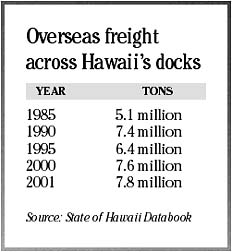

[ ON THE WATERFRONT ]
A hundred years ago, work on Hawaii's docks was hard, hot and downright dangerous. Containerization
changes shippingThe ILWU moves to protect workers
Highlights of waterfront history
when mechanization becomes inevitableBy Russ Lynch
rlynch@starbulletin.comStevedores worked liked coolies, hefting bales and boxes out of holds, while dozens of feet above them, cranes dangled nets loaded with tons of lumber, machines for the burgeoning sugar industry, construction equipment and other essentials for the fast-growing island economy.
More than half a century later, on the last day of August 1958, there was an amazing new development that was to change Hawaii shipping for ever. That was the day that Matson Navigation Co.'s Hawaiian Merchant left San Francisco with 20 gleaming new 24-foot aluminum boxes stacked on the deck.
It was the beginning of containerization.
The shift to containers would make new labor history in just a couple of years.
STAR-BULLETIN / 1949
Resentment against the "Big Five" companies emerged during the 1949 dock strike, which lasted about five months.
A local branch of an international longshore union struck the docks in Hilo in 1935, forcing the reinstatement of some fired workers. That move by the ILA was the beginning of what was to become the International Longshoremen's & Warehousemen's Union, the ILWU, later a leading force in Hawaii labor and politics.
In 1949, the ILWU fought the "Big Five" Hawaii corporations by demanding wage parity with their mainland equivalents. That turned into a strike that lasted 157 days, about five months.
Backed by new federal laws against union-busting, the union reached a settlement that established it for the long term as the representative of workers on the docks.
All along, and particularly after the war, Hawaii's economy was growing. When the 1949 strike took place, there were 5,000 ILWU members working the docks. Now there are about 1,000.
STAR-BULLETIN / JULY 1998
An agreement with the union meant shipping firms such as Matson and CSX Lines, formerly Sea-Land, could spend millions of dollars for cranes and automation to work Hawaii docks.
But the union isn't bothered by that because of its pioneering "mechanization and modernization" agreement with shipping management, reached in 1960 and put into full effect in 1961.
Seeing the inevitability of containerization, in which cranes would lift boxes off ships and swing them ashore onto trailers with little human help, and with shipping lines already planning all-container vessels, the union came to a new understanding in Hawaii and on the West Coast.
Nobody would be laid off, but if the work force had to be reduced because of new equipment, the longest-serving workers would go first and there would be incentives to retire. The shipping companies committed an extra $5 million to the retirement plan of the ILWU.

Those who did leave would get good retirement benefits, and the dwindling number remaining, as the docks got more and more automated, would get better pay and benefits, sharing in the gains they helped create for the shippers.Now firms like Matson and its competitor in the West Coast-Hawaii trade, CSX Lines (formerly Sea-Land) could pour millions into new cranes and automation on the Hawaii docks.
Sand Island has become one of the world's leading container stations, with cargo traffic monitored all the way up to satellites so customers can use computers to find out exactly where their goods are.
Last year, Hawaii's docks handled 7.8 million tons of freight, up 59 percent from 4.9 million tons in 1984, according to the state data book, with nearly 60 fewer vessels arriving from outside Hawaii -- 1,744 ships in 2001 compared to 1,686 in 1984.
BACK TO TOP |
>> 1907: Honolulu Harbor enlarged by dredging Kapalama Basin. Sand Island (then Quarantine Island) created by landfill. Highlights of Honolulu
waterfront history>> 1926: Aloha Tower built.
>> 1949: ILWU shuts down docks in five-month strike
>> 1955: Bulk sugar facilities built at Piers 18, 19 and 20.
>> 1958: Matson brings first deck-top containers to Hawaii aboard Hawaiian Merchant.
>> 1960: Matson's first all-container ship, Hawaiian Citizen, goes into service.
>> 1961: Shipping lines and ILWU put Mechanization and Modernization agreement into effect, to encourage retirement and reduced work force to allow more containerization.
>> 1969: U.S. Lines starts West Coast-Hawaii container service, Matson's first major competition. Matson launches its first new ship built entirely as a container ship, the Hawaiian Enterprise.
>> 1974: U.S. Lines moves to new container yard at Sand Island. Matson goes there, too, and keeps operating at Pier 2.
>> 1987: Competition grows as Sea-Land Service (now CSX) joins West Coast-Hawaii-Guam trade.
Sources: State Harbors Division,
Matson Navigation, Star-Bulletin files